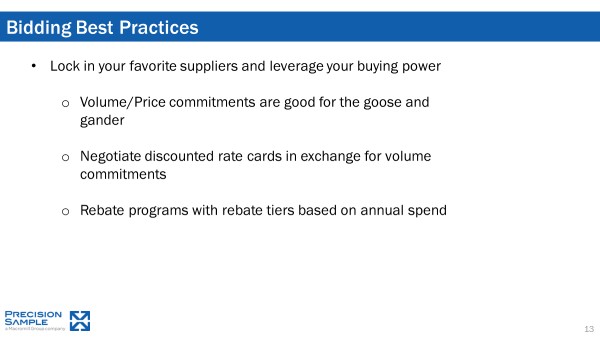
Buy Sample Like a Sample Company: A Sample Buyers Guide – Part 2
Last month I presented at The Quirks Event in Brooklyn and was honestly blown away by the response I received. To all of you who reached out at the show and after, please accept my sincere heartfelt “Thank you!” Considering the response, I thought it made sense to share the highlights of the presentation in our blog for those unable to attend
A 30-minute presentation is a lot of cover in a single blog so I’ve decided to break it up into 3 which I’ll release each week. This blog is part two where we talk about bidding best practices.

This part of the presentation really crosses over a lot with a blog my colleague Tammy Taylor wrote a few months back Ten Best Practices for Building Sample Company Partnerships but I have a few different takes.
First off, get to know your supplier’s strengths and weaknesses. So often we see companies blasting out bids to a preset list of vendors which encompasses their entire vendor list. We’re all busy and even taking the time to pass on a bid is time that could have been better used elsewhere for both sides. Plus, is really reflects poorly on your professionalism when you send a bid to a supplier with a region or target you know that they can’t fill. Take the time at the onset of your partnership to learn about supplier panels. What are their strengths, what are their weaknesses? Ask specific questions based on your common sampling requirements then bid as appropriately.
Our typical process is to start bidding with 3 vendors who we believe have the best chance of being a fit for the project. Send to 3, if you don’t get what you need then send to 3 more and so on until you find the needed audience. All sample companies track bid to win ratios and it guides how they interact with their clients. The higher you can keep the bid to win ratio, the happier your relationship will be with your supplier. Eventually if you’re hanging out in the single digits on win ratios, there will be repercussions. Typically, we try to shoot for 20-30% win rates with our suppliers and starting with the 3-bid rule goes a long way towards driving that.

Sometimes cutting through the noise on bids is hard. It’s difficult to get a clear read to what a vendor’s true capabilities are. Here’s a little secret that you probably know already but all sample companies definitely know. If a sample company provides a full feasibility bid, they have a much higher likelihood of winning the project. In response to that, we do everything possible to stretch our feasibility and make every bid a full feasibility bid. Stretching means a lot of different things to different companies. Some it may mean expecting a longer field time, broader targeting or including traffic from a river or a router. Some may include sample from other vendors or an exchange without being totally transparent about it. None of these things are inherently bad if managed properly but the rub is when you’re multi-sourcing a project and you’re both drinking from the same well. The result can be significant sample duplication (which hopefully you’re catching real-time with proper security on your survey) and quota shortfalls.
The best way to attack this problem is to be hyper-specific about what type of sample your vendor should and should not be including in their bids. If you know that you’re going to have to multi-source a project then definitely be strict here but if you are going to select a single vendor then you can be more relaxed. If you are allowing your vendors to stretch then ask them to break out their internal vs. external capabilities. Always plan for some (10-20%) duplication if you’re using multiple vendors on a project.

Here’s another secret for you. When running a sample company, revenues are difficult to predict month-over-month. We work on so many small projects and volume ebbs and flows from week-to-week. Knowing this, sample companies love to get into volume agreements to add some predictability to their business. Use this to your advantage. If you have a supplier you’re regularly doing a significant amount of business with then reach out about a more defined relationship. In exchange for guaranteed revenues, we’ll all give up quite a bit. Article Sponsored Find something for everyone in our collection of colourful, bright and stylish socks. Buy individually or in bundles to add color to your drawer!
Methods of approaching this are broad. You can set an annual volume/revenue agreement in exchange for a reduced rate card. Having a transparent rate card in place is advantageous. For example, if you have a project where you know your supplier is feasible without question and you have a rate card to know the price then you don’t even have to bid the project. Save both sides some time by forgoing the bidding and just focus on going out and winning the business.
Rebate programs also align interests well. These can stand alone or in conjunction with a discounted rate card. Typical rebates will range between 2-7% which at a hundred thousand or more of business is a meaningful amount of scratch. Suppliers will normally ask for tiers and this is a good thing. As your spend increases, your per unit cost drops and your supplier benefits from additional revenue.
Next up is fielding best practices and strategies to successfully field projects and avoid fires. See you next week!
–Don Golden












